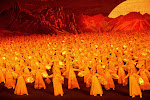 Helloooo...! Niiiiice! So, today we started out by reviewing our vocabulary from the Industrial Revolution (Industrialization, Urbanization, Laissez-faire, & Capitalism). Then we learned about life thru the following pictures...
Helloooo...! Niiiiice! So, today we started out by reviewing our vocabulary from the Industrial Revolution (Industrialization, Urbanization, Laissez-faire, & Capitalism). Then we learned about life thru the following pictures...Storytime! In the picture below, there is a Russian peasant family from around the time of the Industrial Revolution.
Mr. Kameika used the picture told the story of his great-grandmother coming from Russia. She said that when she was about 11 or 12 years old, her parents took her and her brothers and sisters to the coast. There they were taken to a large ship bound for America. Before boarding, her parents gave them burlap sacks (like potato sacks), told them to go to New York City, pick up the gold in the streets of New York, and then return to Russia. As you can imagine, she told me that they never once found any gold... nor did they return to Russia...
The lives of families changed greatly. People moved to cities to work in mostly factories (urbanization) that paid very little. Women now had to go to work, too, because their husbands could not bring home enough money to pay for rent, food, etc. They were not used to paying these things because in the countryside, they usually built their own homes and grew their own food. Not in the city, though!
Children also had to work. Very young children stayed home (usually alone) and eventually resented their hard-working and frustrated parents (whom they rarely saw), and then started getting into gangs and mafia-type business because they did not want to be like their parents and work long hours for little pay. This was the beginning of the "inner city."
(Below) How do you know this is an industrialized city?
What "good" things are going on here?
What "bad" things are going on here?
Check out this factory worker below.
How many things can you say about her and the Industrial Revolution?
Finally, analyze "hidden meaning" in the cartoon below.
Some say that this cartoon is criticizing "Laissez-faire Capitalism" ...are they correct? How can you tell?






































